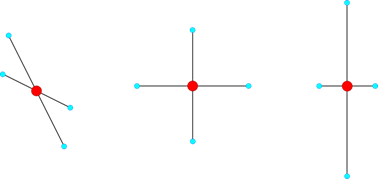
Interpolation elements is a constraint element for the nodes of an FFlex body. This element is similar to what is often called an “RBE3 Element” in finite element software. It constrains a master node to a node set of slave nodes. The constraint requires the master node to be in the average position of the slave nodes and it requires the master node to have an orientation which is the average of the orbits of the slave nodes around the master node.

Figure 1 The translational constraint of the Interpolation element. The position of the master node (red) is in the average position of the slave nodes (blue).
|
|
|
|
(a) |
(b) |
Figure 2 The rotational constraint of the Interpolation element.
(a) The reference configuration of the Interpolation element. (b) The current configuration of the Interpolation element, in which the orientation of the master node is the average rotation of the slave nodes around the master node.
The Interpolation element has some similarities to the constraint-type Rigid element in RecurDyn. Like the Rigid element, it constrains a set of slave nodes to a master node. Both the position and the orientation of the master node is constrained to the positions of the slave nodes. Note that the orientation of the slave nodes is not affected by the Interpolation element, which is different from the Rigid element. Furthermore, the Interpolation element allows the slave nodes to move relative to each other. In contrast, the slave nodes of the Rigid element move with the master node like a rigid body.
The Interpolation element was designed for the purpose of providing connections to FFlex bodies that do not stiffen the FFlex mesh around the connection. The Rigid element, which is also often used to make connections to FFlex bodies, will cause the FFlex mesh to become stiff around the set of nodes that are constrained by the Rigid element. This is due to the fact that the Rigid element is attempts to lock the nodes together as though they were part of a rigid body. The Interpolation element allows the slave nodes to move relative to each other, and therefore, the Interpolation element does not stiffen the FFlex mesh around the slave nodes.
However, the Rigid element is a more general element than the Interpolation element. The Rigid element can be used between a master node and a single slave node. The Interpolation element requires that the slave node set contains at least 4 nodes, and the nodes cannot be co-linear. The constraint-type Rigid element can constrain a master node to a slave node in which both nodes have the same coordinates. The Interpolation element requires that the master node is not in the same location as any of the slave nodes. In general, the Rigid element is extremely robust and can almost always be used to link a set of nodes to a master node of an FFlex body. The Interpolation element requires more care when used.
The Interpolation can also be used to distribute forces or torques to a set of nodes. Translational forces applied to a master node of an Interpolation element will be distributed evenly to all of the slave nodes of an Interpolation element. A torque applied to a master node of an Interpolation element will cause a translational force to be applied to each slave node that is inversely proportional to the length of the arm between the master node and the slave node. In contrast, the Rigid element transmits forces and torques applied to the master node to the slave nodes based on the deformation of the body around the slave nodes.